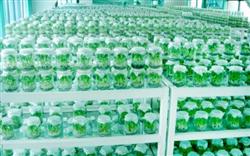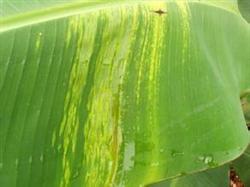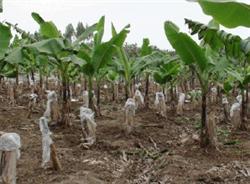What are the key points of banana tissue culture seedling cultivation technology?

Test-tube plantlets are usually disease-free, consistent growth, easy to transport and so on, which is beneficial to the large-scale popularization of improved varieties. Bananas, pink bananas, Longya bananas and even plantains are widely used at present and in the future. However, the seedling stage of test-tube plantlets is weak, the resistance is poor, and they are susceptible to mosaic heart rot and other diseases and insect pests. If they are planted in bad weather, the growing period is also long, and the process of tissue culture is easy to produce variation, and most of the variation is still difficult to identify when planting. In view of these characteristics, the main technical points of planting management are as follows: (1) the test-tube plantlets of soil preparation and soil cultivation are easy to be exposed and should not be planted deeply, so it is best to leave enough soil for future soil cultivation. Paddy field banana garden should use three-level border method, that is, the border is 10-15 cm higher than the planting hole line. With the growth of test-tube plantlets, the soil in the border should be cultivated to the planting hole during fertilization to prevent outcrop. During the preparation of dry land, the border ditch can be shallower for the time being, and then continue to dig deep border ditch to cultivate soil for the plant. (2) planting test-tube plantlets with 6-8 leaves (including 3 leaves of bottle seedlings) can be planted, generally spring planting is better, pre-refine the seedlings before planting, let the seedlings adapt to the natural climate, be careful when opening the seedling bag, do not loosen the bag soil, otherwise it will affect the survival rate and restore growth. (3) the test-tube plantlets of fertilization are extremely intolerant to fertilizer at the initial stage, and the base fertilizer must be applied deeply, and the root system must not be allowed to touch the fertile soil. Farm manure should be mature and deeply applied below 30 cm or beyond 60-80 cm. It can be planted shallowly in rainy days, and then fertilized when pulling out new leaves after planting. Within two months after planting, 0.1% Mel 0.2% compound fertilizer or potassium dihydrogen phosphate, organic fertilizer liquid, Yemianbao, Lvwang series fertilizer, etc., can be used in dry days. As the plant grows, the amount of fertilizer or fertilizer can be larger. It is suitable to apply fertilizer in the middle stage. Once every 15-20 days, and once every 25-30 days in the later stage. It is necessary to strengthen fertilizer and water management for test-tube plantlets planted in spring in order to bud in October for the winter. The test-tube plantlets with sufficient fertilizer and water grow vigorously, and their new tube leaves are spirally curved, and each one is bigger than the other. (4) the initial water requirement of test-tube plantlets under water management is less, but it can not be drought and soil waterlogging. Water should be drenched in time during drought, planting in high temperature period can be covered with planting holes, and in rainy season, attention must be paid to soil drainage. Sticky soil can be removed from the soil 30-40 centimeters outside the planting hole to make the planting hole protruding 5-10 centimeters to prevent planting holes from waterlogging and rotting or injuring roots. (5) to strengthen the prevention and control of mosaic leaf rot in epidemic areas, attention should be paid to the prevention and control of the disease, including the use of old and strong test-tube plantlets with good resistance, timely removal of weeds in the field, non-interplanting virus parasitic crops, and regular spraying of antiviral agents (see prevention and control of mosaic heart rot). Test-tube plantlets are also easily eaten by insect pests such as Spodoptera litura larvae at seedling stage. In some coastal old banana areas in the rainy season, because the leaves of test-tube plantlets are close to the ground, it is easy to get leaf spot disease, so attention should be paid to spraying control. (6) the variants in the nursery stage such as white stripes of leaves, flowers and leaves, abnormal leaves and super short and sturdy seedlings can be easily recognized and removed in time. In addition, there are two kinds of variants which are more variable and difficult to identify at the initial stage. It can only be carefully identified 2-4 months after planting and when the leaf age is more than 15-20. One is the dwarf type, the plant is short and stout, the leaf is broad and thick, the leaf is thicker, the petiole is short, the petiole is short, and the pseudostem is sturdy and dwarf. The other is leaf abnormality, the main symptoms are that the leaf is erect, the leaf margin is completely or partially wrinkled, the leaf surface has irregular or wavy black or waxy spots, some are mixed with irregular transparent spots, and some plants have abnormal leaf order. The above two main mutants can bud and hang fruit, but the yield is very low, the quality is poor, and most of them have no economic value, so they must be found and dug out and replanted as soon as possible. Generally, 5% variants are allowed according to regulations, but some banana plantations reach 10% Mur20%, especially when buying sub-polar seedlings, there are more variants. Usually, 10% more seedlings should be purchased and planted in large bags of 15 cm × 15 cm × 15 cm or directly in the field head, in order to eliminate diseased alien plants and replant them after death. (7) the plants planted by test-tube plantlets with bud removal were born and sucked buds earlier, and the number was large but weak. Due to the late determination of retained buds, these early sucking buds should be removed as soon as possible, and can be removed with a special sharp plantain spade or sickle when the buds are 15-30 cm.
- Prev

Application of Plant growth regulators on Banana
The primary infection sources of the disease are mainly diseased plants, sucking buds and susceptible intermediate hosts (such as tomato, pepper, eggplant, tobacco, cowpea and some weeds). Long-distance transmission mainly depends on sucking buds with virus, while natural transmission in the field mainly depends on cotton aphid and corn aphid. In addition, the disease can also be transmitted through juice friction. Because.
- Next

Banana ploughing and weeding
The main diseases of banana are atrophy, mosaic heart rot and leaf spot, the first two of which are virus diseases transmitted by aphids. 1. Atrophy disease, also known as bunchy top disease, banana male, shrimp banana, the symptom is that the petiole has blue veins, the new leaves become thinner and thinner, wrinkle, form a cluster top, can not bear fruit. The diseased plant should be dug up and burned in time.
Related
- Moge, come on! The staff of the peasant association in the producing area of cantaloupe were frightened when the crowd gathered.
- Causes and Solutions of low Fruit setting rate of Apple
- Symptoms and control measures of passion fruit virus disease
- Fruit growing lesson: how do apple orchards keep high yields?
- Can you build orchards in the mountains? What are the pros and cons?
- How to manage the coloring period of Crisson grape?
- This paper introduces the processing technology of two kinds of fig products.
- How much is a month for retired teachers in rural areas by 2020?
- How can strawberry planting increase sugar content? We should pay attention to management in many aspects.
- What are the cultivation techniques on how to improve the yield of golden fruit?

